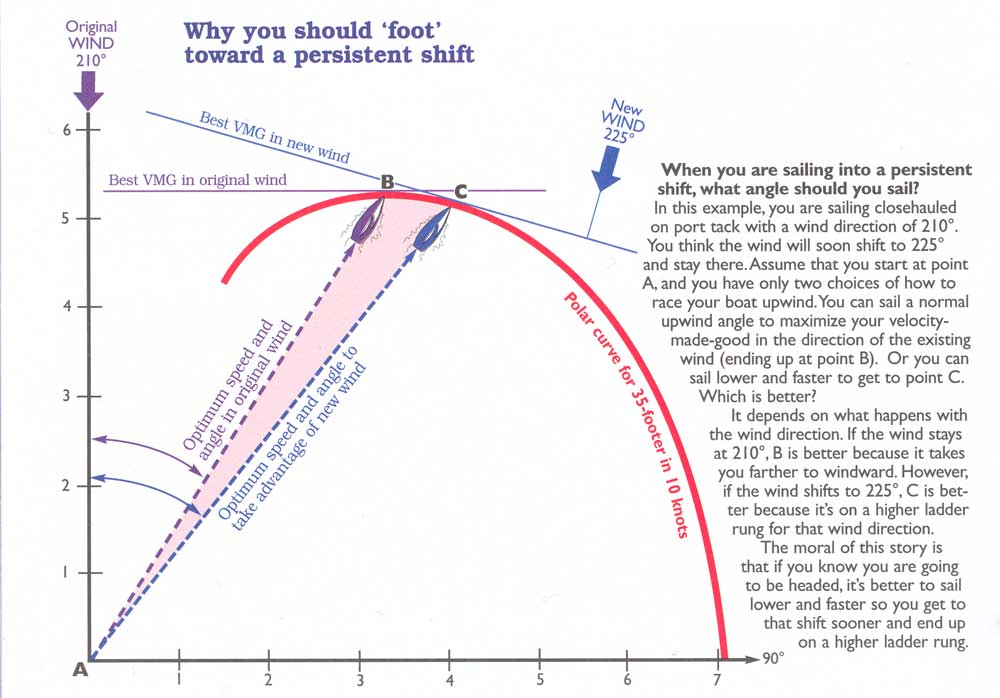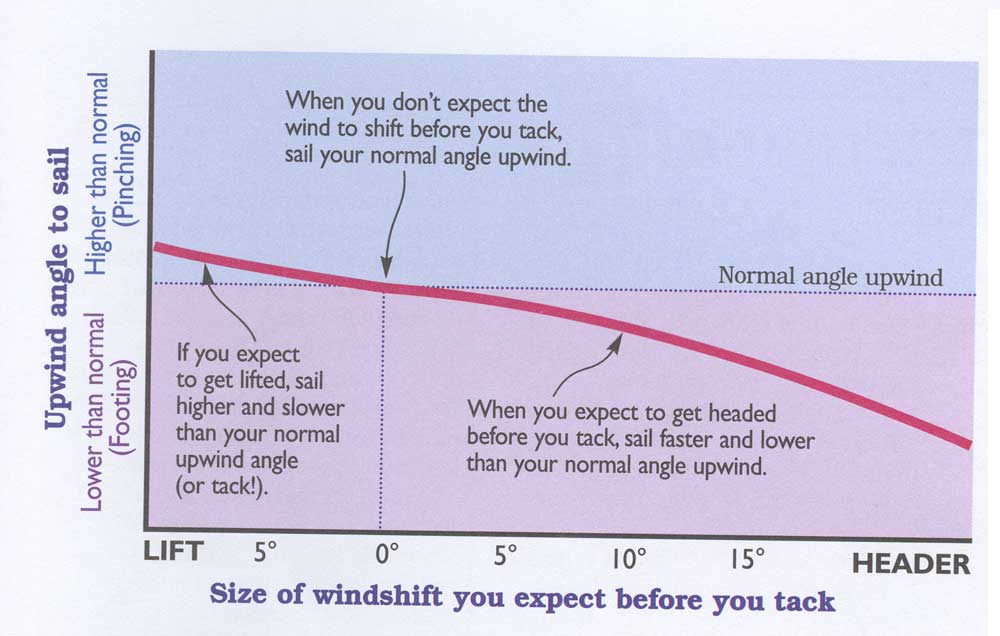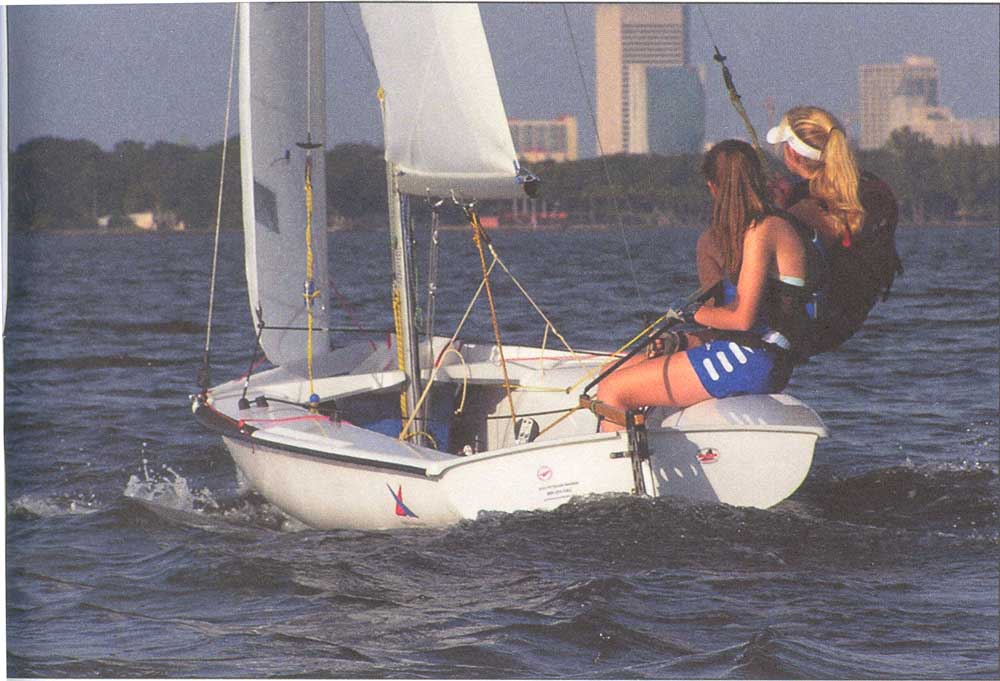by David Dellenbaugh
In a steady breeze, you will get to the windward mark fastest if you always sail your optimal angle upwind (with a few tactical exceptions). This gives you maximum velocity-made-good (VMG) to windward for the wind direction that you have for the entire leg.
If you expect a persistent windshift during the first beat, however, donít
maximize your VMG for the wind direction you have at the beginning of the leg.
That wind will disappear, so optimize your performance for the wind direction
you expect to have when you round the windward mark.
In order to be on the highest ladder rung when you sail into a header, you
should sail a little lower and faster than normal in the breeze you have before
the shift (see diagram below). Sailing faster helps in several ways. First, you
will get to the new shift sooner. Second, when the wind changes direction you
will be closer to the shift. And third, you will end up farther to windward
(relative to the new wind direction) than if you kept sailing your normal upwind
angle.
 |
How confident are you about the wind?
As a strategy, sailing low and fast upwind is a little risky. If the wind
direction doesnít change before you reach the layline, you will have lost ground
to any boats that sailed their optimal upwind angles. You will also lose
distance if the wind direction oscillates or if you tack before you realize the
full benefits of sailing into the header.
Therefore, donít sail below your normal upwind angle unless you are pretty
confident that, before you reach the corner of the windward leg, the wind will
have shifted significantly in the direction you are heading. This confidence
should be based on some thorough research and data you gather using local
knowledge, weather forecasts, wind observations in the course area and so on.
If all your info points to a persistent shift, and if youíre willing to assume a
certain amount of risk, try sailing fast and low. Start conservatively by
bearing off only until your windward telltales fly straight back. If this works,
try going a little further - you may be able to make some nice gains.
 |
When it wonít work to sail fast and low
Even when itís obvious that you are sailing toward a persistent shift, however,
there are certain times you should not sail fast and low. Itís better to stick
to your normal upwind angle when:
Youíre fighting for a lane of clear air - It may be important to maintain
your height so you donít fall into the bad air of boats ahead or to leeward.
This is especially true right after the start when the fleet is still close
together and you are trying to hold a lane of clear air on the long tack toward
the favored side.
You may tack soon - If you are thinking about tacking soon because youíre in
really bad air or youíre almost at the layline (or for any other reason), it
doesnít make sense to sail low and fast because you wonít have enough time to
make gains this way. Instead, sail your normal upwind angle until you tack.
You donít expect a very big shift - Sailing low and fast works best when you
are planning to stay on one tack for a while and youíre anticipating a
significant header. If you expect only a small shift before you tack, you should
probably sail your normal upwind heading. The degree to which you sail lower and
faster is roughly proportional to the amount of header you expect before you
tack (see diagram above).
 |
| When you are sailing toward a persistent shift (e.g. a header close to land), it usually pays to sail a little faster and lower than normal. This is particularly true when a) you have a long way to go on that tack; b) you expect to get a significant header before you tack; and c) you have a clear lane and arenít worried about falling into the bad air of another boat. |
Try this on downwind legs
This concept of sailing a different angle works on runs, too, but instead of
sailing toward the expected shift, you should sail away from it. Also, instead
of sailing fast and low, you should go fast and high. This will get you farther
away from the next shift, and will put you on a lower ladder rung (and therefore
ahead) when the wind shifts. As with upwind, the amount you sail higher and
faster should correspond to a) how long you plan to be on the jibe; and b) how
far you expect the wind to shift before you jibe.
One side benefit of sailing a little faster than normal is that you will have a
wider steering groove. Itís hard to keep the boat going at full speed when
youíre trying to point as high as possible and the sails are constantly about to
stall. This is especially valuable when you have lighter wind, waves or an
inexperienced helmsperson.
Dave publishes the newsletter Speed & Smarts. For a subscription call:
800-356-2200 or go to:
www.speedandsmarts.com